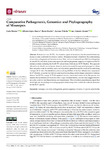2021-06-15Zeitschriftenartikel
Comparative Pathogenesis, Genomics and Phylogeography of Mousepox
Mavian, Carla
López-Bueno, Alberto
Martín, Rocío
Nitsche, Andreas
Alcamí, Antonio
Ectromelia virus (ECTV), the causative agent of mousepox, has threatened laboratory
mouse colonies worldwide for almost a century. Mousepox has been valuable for the understanding
of poxvirus pathogenesis and immune evasion. Here, we have monitored in parallel the pathogenesis
of nine ECTVs in BALB/cJ mice and report the full-length genome sequence of eight novel ECTV
isolates or strains, including the first ECTV isolated from a field mouse, ECTV-MouKre. This approach
allowed us to identify several genes, absent in strains attenuated through serial passages in culture,
that may play a role in virulence and a set of putative genes that may be involved in enhancing
viral growth in vitro. We identified a putative strong inhibitor of the host inflammatory response in
ECTV-MouKre, an isolate that did not cause local foot swelling and developed a moderate virulence.
Most of the ECTVs, except ECTV-Hampstead, encode a truncated version of the P4c protein that
impairs the recruitment of virions into the A-type inclusion bodies, and our data suggest that P4c
may play a role in viral dissemination and transmission. This is the first comprehensive report that
sheds light into the phylogenetic and geographic relationship of the worldwide outbreak dynamics
for the ECTV species.
Dateien zu dieser Publikation

